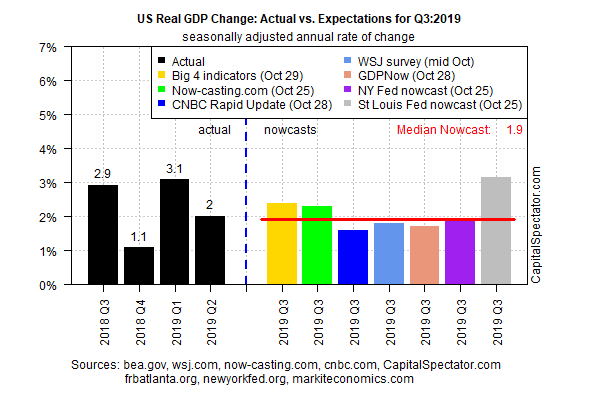Tomorrow’s preliminary estimate for third-quarter economic activity in the US is on track to edge lower, based on the median estimate for a set of nowcasts. The government’s first round of Q3 data (due on Oct. 30) will likely show a modest pace of growth. The report also looks set to show that the economic trend decelerated, if only slightly, for a second straight quarter.
Today’s revised median nowcast is anticipating a 1.9% increase in Q3 growth, based on several models reviewed by The Capital Spectator. This median estimate reflects a fractional slide from the 2.0% gain reported for Q2.

Today’s median update is slightly below The Capital Spectator’s previous Q3 estimate of 2.0%, published on Oct. 9.
Although growth is on track to slow, tomorrow’s GDP report will likely confirm that the longest US expansion on record is ongoing. A key reason, writes former New York Fed Chairman Bill Dudley: “Consumers are in good shape, and the Fed’s rate cuts have kept financial conditions easy. It takes more than age to kill an expansion:”
Typically, either unwanted inflation forces the Fed to snuff out growth, or some shock hits demand so hard and fast that the Fed can’t respond quickly enough to prevent a recession. The yield curve is flat not because short-term rates are high, but because long-term rates are so low. Investors are buying bonds as a hedge against bad outcomes on growth; they’re not worried about higher inflation. Importantly, monetary policy is still supporting growth, as can be seen in home sales and residential construction.
Monetary support in the form of lower interest rates is expected to become a bit stronger tomorrow, based on Fed funds futures. The market is pricing in a 95% probability that the central bank will cut its target rate by 25 basis to a 1.50%-to-1.75% range in Wednesday’s FOMC announcement (Oct. 30).
Meantime, tomorrow’s Q3 GDP data will likely show that a recession isn’t imminent. Nonetheless, the results will stoke new concerns that the recent slowdown will continue. Economists are expecting no less in the quarters ahead, according to new survey published yesterday by National Association for Business Economics (NABE). “The US economy appears to be slowing, and respondents expect still slower growth over the next 12 months,” says NABE’s president, Constance Hunter.
The odds are certainly low at the moment that we’ll see a meaningful re-acceleration in growth in the near term. But it’s not obvious that the macro trend will soon tumble to the point that recession risk spikes higher.
Consider, for example, the outlook for the GDP trend from the perspective of a year-over-year comparison. Through this lens, economic growth may stabilize, more or less, in the quarters ahead. The annual change in growth is expected to hold at or just below the 2% mark for the near term, based on The Capital Spectator’s average estimate via a set of combination forecasts. No one will confuse such a moderate rate as a boom, but it’s enough to keep the economy out of recession — assuming the forecast is accurate.

But in the current environment, it’s also reasonable to assume that forecasts are subject to higher-than-usual levels of uncertainty. Bill Dudley asks and answers the critical question: What can wrong to derail the slow-growth outlook and usher in a worse-than-expected result?
“Sometimes, an adverse event and human psychology can reinforce each other in such a way that they bring about a recession,” he advises. “Given how slowly the economy is growing, even a modest shock could do the trick.”
